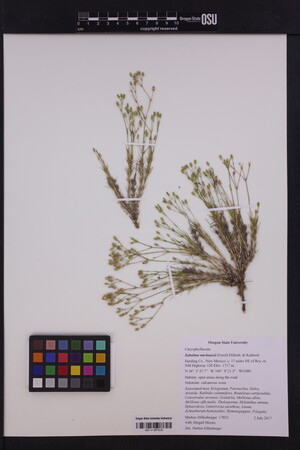Sabulina michauxii
|
Sabulina michauxii (Michx.) Dillenb. & Kadereit
 (redirected from: Minuartia michauxii var. michauxii (Fenzl) Farw.) (redirected from: Minuartia michauxii var. michauxii (Fenzl) Farw.) |
|
|
Family: Caryophyllaceae
Bog Mock Sandwort, more...Michaux's Mock Sandwort, Michaux's Stitchwort
[Alsine michauxii Fenzl, moreMinuartia michauxii (Fenzl) Farw., Minuartia michauxii var. michauxii (Fenzl) Farw., Minuartia stricta (Sw.) Hiern., Sabulina stricta (Sw.) Rchb.] |
Plants perennial, cespitose, sometimes matted. Taproots thickened, woody; crown many-branched, thickened. Stems erect to ascending, green, 8-40 cm, glabrous, internodes of flowering stems 0.5-10+ times as long as leaves. Leaves tightly overlapping in proximal 3 of stem, variable spaced, usually connate proximally, with loose, scarious sheath 0.2-1 mm; blade erect to spreading, green, flat or convex to 3-angled, 1-3-veined, prominently so abaxially, filiform, linear to linear-lanceolate, 8-30 × 0.5-1.8 mm, rigid, margins not thickened, ± scarious, smooth, apex green, blunt to pungent, flat to navicular, shiny, glabrous; axillary leaves present among vegetative leaves. Inflorescences 5-30-flowered, lax to congested cymes; bracts narrowly lanceolate to subulate, herbaceous, margins scarious. Pedicels 0.3-6 cm, glabrous. Flowers: hypanthium dish-shaped; sepals 3-veined, ovate to lanceolate (herbaceous portion ovate to narrowly lanceolate), 3-6 mm, not enlarging in fruit, apex green, acute to mostly acuminate, not hooded, glabrous; petals oblong-obovate, 1.3-2 times as long as sepals, apex rounded, entire. Capsules on stipe ca. 0.1-0.2 mm, ellipsoid, 3-4 mm, usually shorter than sepals. Seeds black, suborbiculate, compressed, 0.8-0.9 mm, tuberculate; tubercles elongate. 2n = 30(-), 44. Flowering spring-summer. Dry, calcareous gravel and ledges; 0-1000 m; Ont., Que.; Ala., Ark., Conn., Del., Ill., Ind., Iowa, Kans., Ky., Md., Mass., Mich., Mo., Nebr., N.H., N.J., N.Mex., N.Y., Ohio, Okla., Pa., R.I., S.Dak., Tex., Vt., Va., W.Va., Wis. We concur with J. A. Steyermark (1963) and G. Yatskievych and J. Turner (1990) that the concept of Arenaria texana originally put forth by Britton requires further study. Plants labeled as Minuartia michauxii var. texana have slightly shorter leaves that are crowded into the proximal one-third rather than one-half of the somewhat shorter stem. The plants are often in the southern part of the range and may, as Steyermark noted, be associated with more open, xeric habitats.
Plants perennial, cespitose to mat-forming. Taproots filiform to slightly thickened. Stems ascending to erect or procumbent, green, (0.8-)3-12 cm, glabrous, internodes of all stems 0.5-10 times as long as leaves. Leaves barely if at all overlapping, connate proximally, with tight, scarious to herbaceous sheath 0.2-0.5 mm; blade straight to slightly outward curved, green, flat, 1-veined, occasionally 3-veined abaxially, linear to linear-oblong or subulate, (2-)4-10 × (0.3-)0.5-1.5 mm, flexuous, margins not thickened, scarious, smooth, apex green or purple, mostly rounded, slightly navicular, shiny, glabrous; axillary leaves present among proximal cauline leaves. Inflorescences 1-3(-5)-flowered, open cymes or flowers solitary, terminal; bracts subulate, herbaceous. Pedicels 0.3-3 cm, glabrous. Flowers: hypanthium disc-shaped; sepals 1-3-veined, often prominently, becoming ribbed in fruit, broadly elliptic to ovate (herbaceous portion broadly elliptic to ovate), (1.5-)2.5-3.2 mm, to 4 mm in fruit, apex green to purple, acute to acuminate, not hooded, glabrous; petals lanceolate to spatulate or orbiculate, (0.6-)0.8-1 times as long as sepals, apex rounded, entire, or petals rudimentary or absent. Capsules on stipe ca. 0.1-0.2 mm, ovoid, 2.5-3.2 mm, shorter than or equaling sepals. Seeds brown or reddish brown, orbiculate with radicle prolonged into rounded bump, somewhat compressed, 0.4-0.6 mm, smooth or obscurely low-tuberculate (50×). 2n = 22 (Europe), 26, 30 (Europe). Flowering spring-summer. Moist, granitic gravels, sedge meadows, heath, alpine or arctic tundra; 100-3800 m; Greenland; B.C., Nfld. and Labr. (Labr.), N.W.T., Nunavut, Ont., Que., Yukon; Alaska, Calif., Colo.; Europe; Asia. Minuartia stricta is circumpolar and sometimes has been included within M. michauxii (e.g., B. Maguire 1958; H. J. Scoggan 1978-1979, part 3). Plants from alpine sites in California are, in spite of smaller stature and often smaller floral parts, Minuartia stricta. Colorado populations appear to vary widely in habit, but floral and fruit features match M. stricta.
From Flora of Indiana (1940) by Charles C. Deam Local in northern Indiana where it usually grows in very sandy soil on black and white oak ridges. It is abundant on Hanging Rock along the Wabash River in Wabash County. .…… Indiana Coefficient of Conservatism: C = 10 Wetland Indicator Status: N/A |





































































